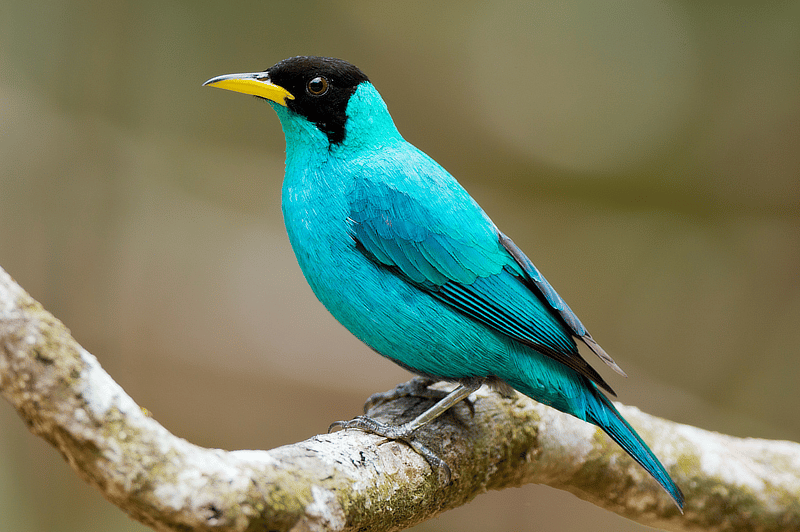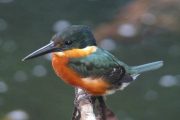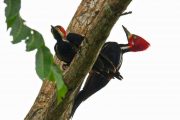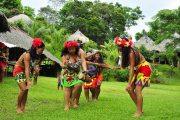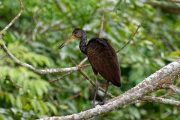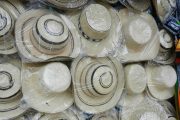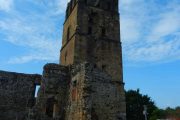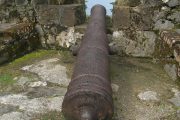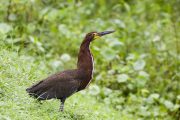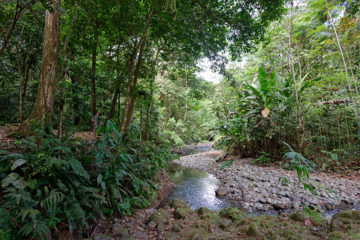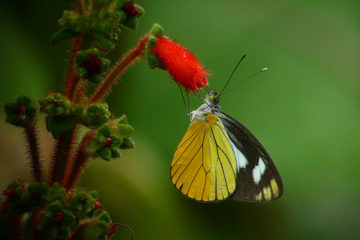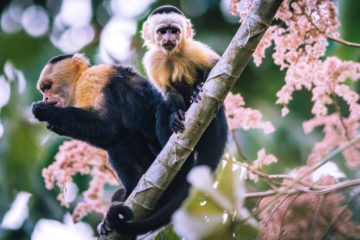This is the tour for birders who love history and for history buffs who love birds! Panama is a country rich in both, and the Canopy Tower is the ideal base of operations! Panama City was the first city founded by Spaniards on the Pacific shore of the New World, the site of the first transcontinental railroad and the home of the Panama Canal, 8th Wonder of the World — all amidst 970+ species of bird and home to an annual raptor migration second to none in the world! Enjoy seven fun-filled days with tales of legends, pirates, visionaries, conquistadors and with the most beautiful birds you can imagine — many right outside your bedroom window!
7 Night Package (2025): High Season: $3,302 — Green Season: $2,174
7 Night Package (2026): High Season: $3,402 — Green Season: $2,240
Rates in US$ per person (+ taxes), double occupancy
Day 1
Arrival, Orientation & Observation Deck
Upon arrival at the airport, you will be met by our driver who will transfer you to the Canopy Tower, located at the top of Semaphore Hill in the rainforest of Soberanía National Park. A member of our staff will greet you as you arrive at the Tower, and you will be provided with an orientation on the use of the facilities. At this time we will answer any questions you may have. As your luggage is being ferried to your room, you may visit the dining/bar area and enjoy a refreshing drink. We highly recommend that you spend some time on the Observation Deck. The view from the platform is incredible! Here, you get a unique eye-level perspective of the rainforest canopy. Many birds, including toucans, parrots, tanagers, hawks and dozens of others, as well as monkeys, two species of sloth and other mammals are commonly seen. From this vantage point you can also see ships traversing the Panama Canal, the majestic Centennial Bridge and miles of rainforest! You may also want to watch the hummingbird feeders at the base of the Tower for Long-billed Hermit, White-necked Jacobin, Violet-bellied & Blue-chested Hummingbirds and White-vented Plumeleteer. Occasionally, a Snowy-bellied Hummingbird is spotted! Dinner will be served at the CANOPY TOWER, and we have a long nature expedition the next day, so eat up!
Day 2
AM: Semaphore Hill Road
Your guide will be waiting for you at the Observation Deck for early morning guided bird watching. While you look for birds you can enjoy hot coffee, tea and orange juice. Some of the bird species that we are likely to see from the observation deck are Green & Red-legged Honeycreepers, Green Shrike-Vireo, Blue Cotinga, Scaled Pigeon, Mealy & Red-lored Parrots, Keel-billed Toucan, Collared Araçari, a huge diversity of tanagers and flycatchers, and raptors including King Vulture and Black Hawk-Eagle! After breakfast, at mid-morning, you’ll start exploring Soberanía National Park by taking a pleasant walk down Semaphore Hill Road. This winding, shady paved road, festooned on the shoulders by wildflowers of many types, is a little more than a mile long and crosses a large creek about half-way down. The bird list here is extensive, and includes birds from the forest interior as well as edge-dwellers. Olivaceous Flatbill, Plain Xenops, Lesser Greenlet, Black-breasted & White-whiskered Puffbirds, Fasciated & Black-crowned (formerly Western Slaty) Antshrikes, Slate-colored Grosbeak, Bay-headed & White-shouldered Tanagers, Black-throated & Slaty-tailed Trogons, Broad-billed & Rufous Motmots and even Great Jacamar may be found. Great Tinamou is often heard but harder to see. This road is also great for raptors, such as White, Tiny & Great Black Hawks. During migration it’s easy to see more than 10 species of warblers and migratory songbirds in one morning. Your morning bird list will be impressive, as we get a much-welcomed ride back from this morning’s bird tour, just in time to enjoy a delicious lunch at the CANOPY TOWER.
PM: Panama’s Biodiversity Museum (BioMuseo)
This afternoon we will visit the recently opened BioMuseo along the Amador Causeway in Panama City. This spectacular and unique building, designed by renowned architect Frank Gehry, features several halls focusing on the biodiversity of the isthmus of Panama—from its geological beginnings through to modern day culture, the great faunal interchange over the land bridge and other fascinating exhibits. Our visit will no doubt open our eyes further to the incredible biodiversity of Panama! And don’t forget your binoculars, as we may see Brown Pelicans and Magnificent Frigatebirds flying over the Pacific entrance to the Panama Canal!
Day 3
Portobello & San Lorenzo FULL DAY
As we go out of the Soberanía National Park towards the Caribbean coast, we’ll make a quick stop at Las Cruces Trail, which was used by the Spanish conquistadors during colonial times for sending goods, such as gold and silver, from Peru to Panama. Once in Portobello, you’ll start your historical tour by visiting several Spanish forts, the Custom House built in 1630 and its museum, which explains the famous “Triangle of Panama,” the three different routes the Spaniards used to transport the gold and silver by ship to Spain. Also, you’ll stop at the Church of Portobello where you will hear the fascinating tale of the “Black Christ,” the patron of the people of Portobello. Every October 21, Portobello relives a day of its glorious past in a celebration in honor of the Black Christ, with the city filled with people in a candlelight procession. You’ll enjoy a delicious Caribbean lunch at a local restaurant. After lunch you will explore more of the culturally-rich Caribbean coast of Panama! Once at Fort San Lorenzo you immediately realize why the fort was built by the Spanish: it sits high on a cliff overlooking both the Atlantic Ocean and the entrance to the Chagres River, a perfect defensive position. The fort was captured in 1671 by Privateersman Henry Morgan for access to Panama City. Also very important for the city of Colón, in 1855 the Panamá Canal Railroad became the first transcontinental railroad, built by the United States to accommodate the increase in traffic between the eastern US and California during the Gold Rush of 1849. Additionally, the Canal would have been impossible to build without the railroad. During our return, we look for Snail Kites (often 10 or more!), Limpkins & others from our van. Dinner at CANOPY TOWER.
Day 4
AM: Word Famous Pipeline Road
After breakfast you board the Birdmobile or El Tinamu, both open-air vehicles, to take you on your nature expedition to the Pipeline Road, the best place in Central Panama to find forest birds, and one of the premier birding spots in the world! Eight species of wrens, 5 trogons, 4 puffbirds, 3 motmots, many antbirds and even more flycatchers and other birds have been recorded here, including even the elusive Rufous-vented Ground-Cuckoo and the majestic Harpy Eagle! This morning we concentrate our efforts at the beginning of Pipeline, where secondary woods and brushy borders transition into mature forest, ideal for bird diversity! Greater Ani, Gray-cowled Wood-Rail, Yellow-tailed Oriole, Masked Tityra, Rosy Thrush-Tanager, Isthmian Wren, Streaked Flycatcher, Gartered Trogon, Red-throated Ant-Tanager, Squirrel Cuckoo, Gray-headed Chachalaca, Southern Bentbill, Forest Elaenia, Panama Flycatcher, Blue Ground Dove, Little Tinamou and many other birds have been recorded here. Army ant swarms are found frequently, attended by a flurry of birds including Bicolored, Ocellated & Spotted Antbirds. Plus, we will listen for manakins clacking at their leks, always a favorite of birders. Pipeline Road is also a great place for raptors. All three forest-falcons can be heard if not seen, and Tiny Hawk, Semiplumbeous Hawk and Ornate Hawk-Eagle are occasionally seen. A Harpy Eagle was found once right beside the road! Lunch at CANOPY TOWER.
PM: Summit Nature Park & Harpy Eagle Exhibit
Summit Nature Park is a center for recreation, education, conservation and investigation dedicated to reflecting and enhancing Panama’s tropical and cultural diversity. There is a small zoo where you can get a better look at King Vultures, Great Curassows and four species of macaws, as well as Jaguar, spider monkeys, and a host of other mammals. The botanical gardens are great for migratory warblers and other forest-edge species, including a colony of Chestnut-headed Oropendolas, Yellow-margined Flycatcher, and even Blue Cotinga! The Harpy Eagle is Panama’s national bird, and this park is the site of the Harpy Eagle Exhibit, proudly sponsored by SONY Corp. You may view a video about this magnificent raptor. A life-size nest and several panels, which trace the importance of the Harpy Eagle in Panamanian history and culture dating back to Pre-Columbian times, are on display. There is also a Harpy Eagle in a gigantic enclosure. Dinner at CANOPY TOWER.
Day 5
Historic City Tour FULL DAY
After breakfast you will depart for a historical tour of the major cultural & historical sights of Panama City. You begin your historical tour in the old city, Panama La Vieja, founded in 1519 by Spain and later destroyed by the infamous pirate Henry Morgan. You’ll visit the ruins and the museum, which contains exhibits focusing on pre-Hispanic and Colonial times. Afterward, you continue to the World Heritage Site Casco Antiguo, which was originally built and settled in 1671 after the destruction of Panama Viejo by Morgan. Casco Antiguo, also called San Felipe, was constructed as a walled city on a peninsula near Panama City to protect its settlers against another siege such as that suffered by Panama Viejo. We also visit beautiful historical churches, the Heron’s Palace (Palacio de las Garzas, the home of the President of Panama), Plaza de Francia, Independence Plaza, National Theater and others. You’ll take some time to visit the Museo Interoceanico. This old building was once the Grand Hotel and later the French Canal headquarters. The museum gives you a good understanding of why the isthmus is the center of world trade. It also explains the effect the isthmus and the canal have had on Panamanian identity, and provides information on the construction of the Canal. We will enjoy lunch at a restaurant on the Amador Peninsula, where a beautiful tree-lined causeway leads to hotels, fishing vessels and popular night spots. From the causeway, you can take in a view of both the old colonial city and the modern city of Panama—with its impressive skyline as a backdrop! During the afternoon we’ll continue the historical tour by visiting the Miraflores Locks at the Panama Canal, one of the wonders of the modern world, and a must-see for any visitor to Panama! The Visitors’ Center features a fully equipped theater, three observation terraces and four exhibition halls. The exhibits include historic pieces, video presentations, models of plants, animals and fossils, models of the Panama Canal, and objects used in Canal operations. Most importantly, we will be able to see huge ocean liners passing through the century-old locks! Dinner at CANOPY TOWER.
Day 6
AM: Panama Rainforest Discovery Center
After breakfast we depart to the Panama Rainforest Discovery Center, which is an ecotourism and environmental education facility created and administered by Fundacion Avifauna Eugene Eisenmann. It is located off Pipeline Road adjacent to Soberanía National Park. The center contains several attractions, the best of which is a 100-foot-tall observation tower, with 4 rest platforms—each stopping at a different layer of the rainforest. The view from the top is incredible! Here, we scan for raptors like Double-toothed Kite and Semiplumbeous Hawk and canopy birds like Scaled Pigeon, Pied Puffbird, and Blue Cotinga. Also, we explore the 1.1 kilometer circuit of well-maintained forest trails, one ending at a pond, which is excellent for birds! Snail Kite, Wattled Jacana, Little Blue Heron, Least Bittern, and Sungrebe are often resident at the pond, and along the trails we look for White-necked & White-whiskered Puffbirds, motmots, trogons, manakins, antbirds, wrens, tanagers, flycatchers, and many others. The covered Visitor Center has several hummingbird feeders (attracting many species that may be photographed easily), bathrooms, lunch tables and a small gift shop with drinks and snacks. Lunch at CANOPY TOWER.
PM: Plantation Trail
After lunch, we take a short ride to the bottom of Semaphore Hill to Plantation Trail, one of our premier birding areas, often said to rival the Pipeline Road itself! This easy trail passes through mature rainforest and follows a small creek (Rio Chico Masambi) and is a reliable place to find Golden-crowned Spadebill. Oftentimes at the parking area near the entrance we find Black-chested Jays. Other birds to look for along the trail include Ocellated, Bicolored, Chestnut-backed, White-bellied & Spotted Antbirds; Broad-billed & Whooping Motmots, five species of trogon; White-whiskered Puffbird; hummingbirds (Blue-chested, White-necked Jacobin and others); Plain-brown, Northern Barred, Cocoa, and Ruddy Woodcreepers; Cinnamon, Crimson-crested & Black-cheeked Woodpeckers; White-breasted Wood-Wren; Song Wren; Dot-winged, Checker-throated & White-flanked Antwrens; Purple-throated Fruitcrow; Bright-rumped Attila; Gray-headed Tanager; Long-billed Gnatwren; Black-crowned & Fasciated Antshrikes; Red-capped & Blue-crowned Manakins; Great Tinamou; Ruddy-tailed, Royal & Yellow-margined flycatchers; Yellow-rumped Cacique; Scaly-throated Leaftosser; and, occasionally, Great Jacamar or the endemic Yellow-green Tyrannulet! Dinner at CANOPY TOWER.
Day 7
AM: Jungle Boat Tour & Indian Village
After breakfast this morning, we board a small boat for a spectacular nature expedition on the Panama Canal. Most of the Canal is actually an artificial lake, Gatun Lake, and our tour will take you from Gamboa—just 15 minutes from the Canopy Tower—to the interior of the large lake! Along the way you will pass huge cargo ships and ocean liners. You will also visit hidden caves and beautiful inlets with fascinating fauna and flora. We will stop at the “monkey island” for a closer look at White-faced Capuchins. On the way back we will visit a village of the indigenous Embera community. This unique opportunity allows you to learn about Embera culture, their ways of living and their knowledge of rainforest plants, a science known as ethnobotany. They’ll serve you a traditional Embera meal, hot fish and green plantains. You are also welcome to enjoy and purchase a variety of handicrafts. Lunch at CANOPY TOWER.
PM: Old Gamboa Road & Summit Ponds
Old Gamboa Road and the associated ponds at Summit are great places to find Canal Zone birds. At Summit Ponds we will scan for Green, Striated, Capped & Boat-billed Herons as well as Green, Ringed, Amazon, Green-and-rufous (rare) & American Pygmy Kingfishers, which are all resident here! Also we seek out Rusty-margined & Streaked Flycatchers, Mangrove Swallow, Bat Falcon, Cocoa Woodcreeper and Lineated Woodpecker. Going straight past the two ponds you’ll be on Old Gamboa Road, one of the birdiest spots around. This road passes through a variety of habitats and has plenty of specialties, including Blue Ground Dove, Great Antshrike, Jet Antbird, Black-tailed, Bran-colored & Royal Flycatchers, Lance-tailed & Golden-collared Manakins and the delightful Rosy Thrush-Tanager! We also search for White-bellied Antbird, Yellow-bellied Elaenia, Yellow-backed Oriole, Boat-billed & Fork-tailed Flycatchers, Yellow-headed Caracara and more. Also resident are Gray-headed Chachalaca, with Spectacled Owl a real possibility, too, as the guides know where they often roost. Dinner at CANOPY TOWER.
Day 8
Breakfast & Good-byes
After breakfast and after one last look from the Observation deck for lasting memories, we take you to the airport for your international flight home.
Please note that the itinerary is flexible, and may change without prior notice due to weather, alterations in habitat or other conditions.
Canopy Tower
The Canopy Tower is located in impressive rainforest atop Semaphore Hill within Soberanía National Park, 35 miles north of Panamá City in the Republic of Panamá right in the center of the New World— and just 2½ hours from Miami! It’s one of best locations for birding lodges in Panama.

